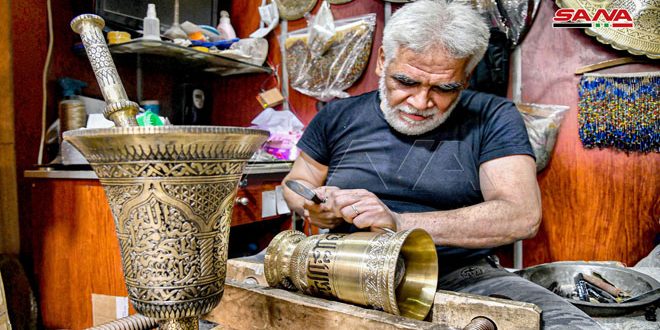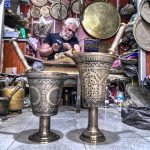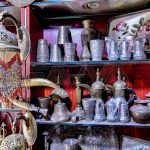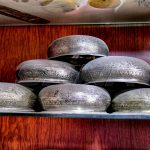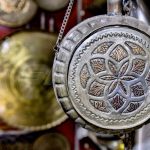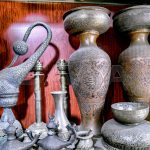Damascus, SANA- An iron hammer, pens for engraving and planning, a wooden base and a compass are the tools with which craftsman Ayman Zarda begins his daily journey to make a Damascene copper masterpiece that later works its way and settles in one of the Syrian, Arab or European homes.
Between antique copper pieces with the smell of the past, craftsman Zarda sits working in the middle of his shop at the ancient Midhat Pasha Souq “market” with the distinguished sound of carving which comes from his small hammer with which he carves on a cooper piece in front of him.
“First we select the piece that we want to work on and draw the initial lines, then we start engraving, and after that, we determine the outer frame of the drawing chosen by the customer, then we engrave the tracks and we dry the specified drawing to highlight it further, until the last step in which the copper piece is polished with special materials to show the shine,” Zarda tells SANA reporter.
The profession of engraving on copper which Zarda who is “one of the few craftsmen who still practice this profession in Damascus” inherited from his father since the seventies and continued to embody it even today despite the change in its use over time and the modifications that made to the shapes of copper and its inscriptions.
Today, most of the copper engraving products have turned into traditional decorative tools that many Syrians still want to acquire as masterpieces to showcase at home or as gifts to expatriates, or they are exported to Arab and European countries, according to the craftsman Zarda.
Despite the decline in the spread of the profession in the modern age, the options available for the shapes and pieces of engraving have become more variable, as Zarda mentions.
“In the past, we used to work within a small scale, such as household utensils and trays, but nowadays, options have become more available, such as engraving on copper grates and coffee Dallah “traditional Arabic coffee pot used for centuries to brew and serve Arabic coffee”, in addition to decorating paintings, chandeliers, incense burners, boxes and copper lamps.”
And he continued, “The export outside Syria has become wider because the fame of the Damascene inscriptions extended to the Arab world and Europe, and many of our customers have been foreigners.”
Engraving on copper requires great effort, focus and accuracy, as the period of work on a single piece ranges from three days to a week depending on the size of the piece and the method of engraving and the customer’s request, according to craftsman Zarda who adds that some people ask to write words of wisdom on the copper piece or their names or a specific drawing of their own.
Ruaa al-Jazaeri
 Syrian Arab News Agency S A N A
Syrian Arab News Agency S A N A
